Today, developing a robust content strategy for your business is more important than it’s ever been.
89% of B2B marketers are now using content marketing to grow their businesses, as are 86% of B2C marketers, with two-thirds of both cohorts expressing that they are “extremely” or “very” committed to the practice.
As such, 70% of B2B marketers and 73% B2C marketers say that they will be creating more content this year than they did last year, according to research from iMPACT.
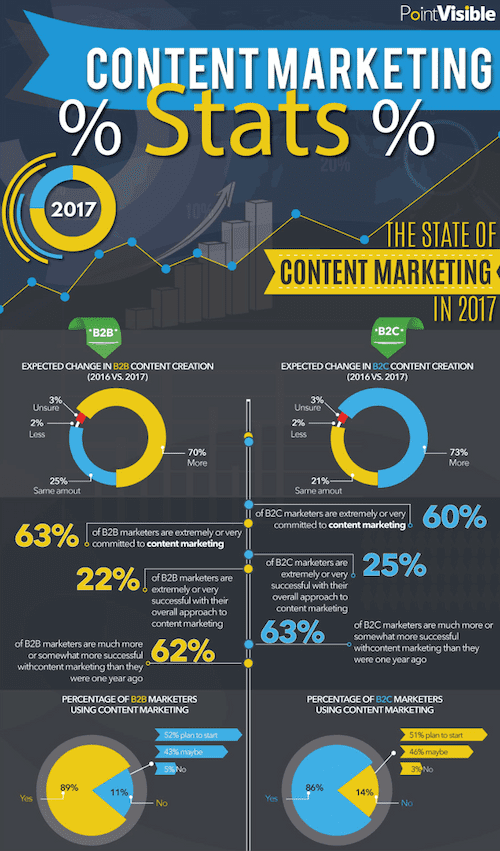 (Image source: impactbnd.com)
(Image source: impactbnd.com)
The reason for the rising numbers is simple – today’s consumers are online, so that’s where businesses and brands need to be as well.
The Benefits of Content Marketing
Content forms the core pillar of all inbound digital marketing efforts. The content produced will serve to improve a business’s discoverability in search, drive website traffic, produce brand lift, generate leads, nurture prospects. Which in turn play a significant role in closing sales.
With 77% of internet users reading blogs, it’s no wonder that the above is achievable with the simple, regular publication of well-researched and well-written articles on a company’s website.
Indeed, research has found that small businesses that small businesses that blog generate 126% more lead growth generate 126% more lead growth than small businesses that don’t. To put this into perspective, B2B marketers who use blogs generate 67% more leads per month than those that don’t – in B2C, the figure is 88% more.
And these figures take blogging into account. For indeed, a thorough and diverse content strategy will incorporate much more than blogs – it also needs things like videos, eBooks, infographics, webinars, social media posts and podcasts.
In fact, according to the Content Marketing Institute’s latest report, the average company utilises no less than eight different content tactics as part of their ongoing content strategies.
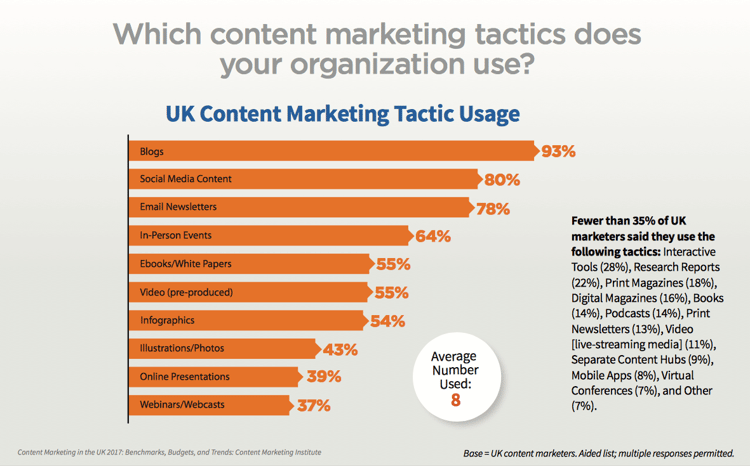 (Image source: contentmarketinginstitute.com)
(Image source: contentmarketinginstitute.com)
Blogs, as you can see, are the most widely-used tactic, and they should indeed form the cornerstone of your content marketing efforts – no matter if you’re in B2B or B2C.
But is a company blog enough on its own? Do you need to be doing more to make your content marketing efforts pay off? Indeed, do you need to get more aggressive with your content strategy?
Let’s consider some of the tell-tale signs that it might be time to up your game.
Signs You May Need to Get More Aggressive with Your Content Strategy
1. Site Traffic is Dwindling
All content management systems (CMSs) provide visitor analytics – but even if you’re using one that doesn’t, you need to find a way of measuring website traffic.
Google Analytics is the obvious place to start, but other tools such as HubSpot also offer analytics functionality.
It’s important to keep an eye on site traffic, as these visitors will have been attracted by your ToFU (top-of-the-funnel) content and the numbers are a prime indicator of how hard your content marketing efforts are working for you.
ToFU content is the stuff that attracts people to your website in the first instance. These types of content creation pieces will be designed to generate conversations and interest in your company and make your inbound marketing personas aware that your business exists.
If you find that your site traffic is dwindling, it may be that you’re not producing enough content to get your company noticed.
Research from HubSpot reveals that content strategists at companies that produce 16+ blog posts a month see more than four times as much traffic as those who post between zero and four times. Perhaps it’s just common sense – the more hooks you cast into the water, the more fish you’re likely to catch.
In short, if your site traffic is falling down a cliff, it might indeed be time to get a little more aggressive with your content marketing strategies.
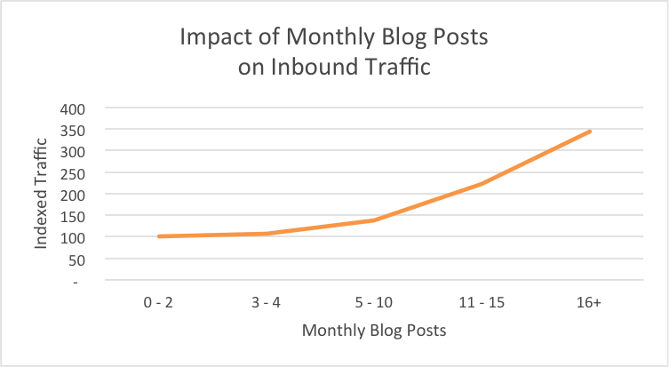 (Image source: blog.hubspot.com)
(Image source: blog.hubspot.com)
2. You're Not Showing Up in Search
Here's a joke for you. Where’s the best place to hide a dead body?
Answer: The second page of Google.
Search engines need content to crawl so it can return relevant results to search queries.
This means that content marketing is essential to SEO (search engine optimisation). It’s important that your website is SEO optimised for the relevant keywords and key terms that users will be typing into search fields when trying to find a business like yours.
These keywords help your website rank highly in SERPs (search engine results pages) and the best way to build them into your website (without embarking on the black hat practice of keyword stuffing) is through the publication of regular blog posts.
Traffic and backlinks also help you rank in search – and once again, a solid content strategy will help generate both.
3. You're Not Generating any Leads
Blogs and other content are not just used at the ToFU stage of the sales funnel. They’re also essential for generating leads.
A lead is someone who has expressed an explicit interest in your content and/or your company. Usually, this means they’ve surrendered some contact information in exchange for access to an eBook, white paper, webinar or what have you. Once someone has done this, they become a lead and move into the middle of the sales funnel (the MoFU stage).
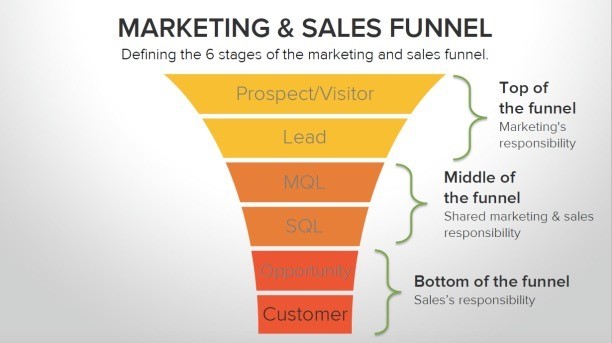 (Image source: endocreative.com)
(Image source: endocreative.com)
Blogs alone can generate leads, such as when a visitor reads a blog and then, adequately inspired, heads over to the website’s Contact Page to reach out for more information. But, this rarely works in practice.
A solid content strategy will try to seamlessly move a lead through the sales funnel using various content tactics.
ToFU blogs attract anonymous visitors, but, within the blog, a CTA (Call To Action) will be strategically placed, guiding readers towards a higher-value piece of content – let’s say, an eBook.
To download this eBook, the visitor must fill out a form, surrendering their contact information, which will include an email address. Armed with the address, the marketer can start to email this lead with various other content assets that serve to educate about the benefits of the product or service. As the lead is nurtured in this manner over time, eventually they will be ready for a sales call, where, hopefully, a sale will be made.
Blogs or social media posts alone can’t really target or nurture leads in this manner. As such, sometimes, getting more aggressive with your content strategy simply means being more thorough.
It means creating a lead flow that first attracts visitors, and then converts those visitors into leads, those leads into opportunities, and those opportunities into sales.
This is the inbound marketing method, which looks like this:
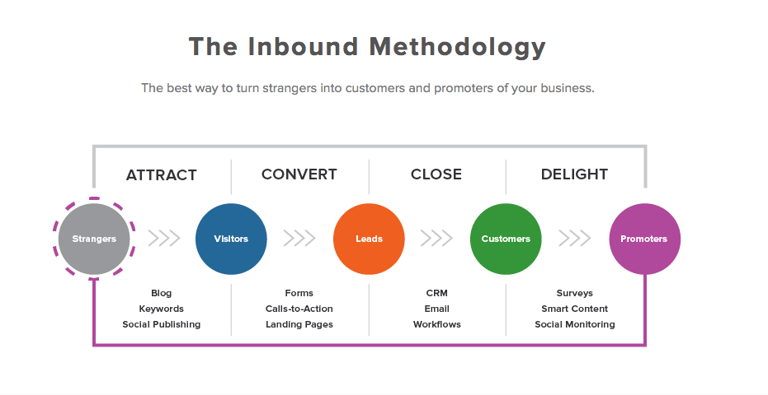
(Image source: hubspot.com)
It’s not so much aggressive as it is strategic. But, ultimately, generating leads is exactly what a content strategy is supposed to do – for you don’t get sales without leads.
And so, if you’re struggling to generate leads, it’s probably time you considered upping your content marketing game.
Over to You
Content marketing is a powerful tool in today’s digital world. It’s imperative for driving traffic, raising brand awareness, for SEO, for generating and nurturing leads, and closing deals.
If you’re struggling with any of these metrics, then it’s almost certain that you need a more aggressive – or at least thorough – content strategy to take your business to the next level.
If you need help with your content strategy or any of your content marketing efforts, then book a Free Growth Marketing Session with our co founder Julia Payne.








